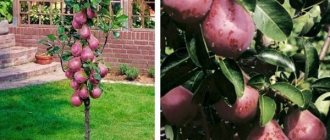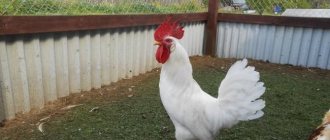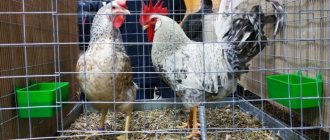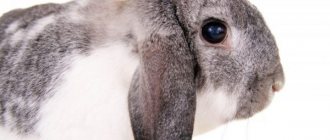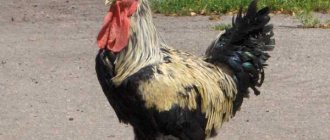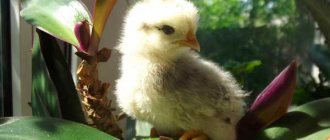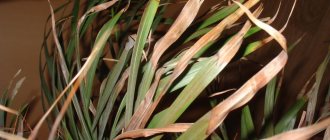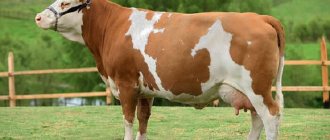The first mention of the variety was in Bern in 1806, Switzerland. Since its appearance, 80 years later, the breeding of Simmental dairy cows has been practiced on all six continents.
In the 19th century, Simmental spread to Eastern Europe and Russia, eventually reaching South Africa in 1895. Guatemala imported the first animals in 1897, and Brazil and Argentina in 1918.
In the twentieth century, in October 1968, the American Simmental Association was created. After this, the burenka began to be popularized in Great Britain, Ireland, Norway and Sweden (in 1970). The first Simmental bulls were imported to the USA in 1971, Australia received their semen and the animals themselves only a year later, in 1972.
In the former USSR, representatives of Simmental cattle accounted for ¼ of all cattle. In 1990 there were 12,849,800 heads. In 2003, there were 2,970,400 cows in the Russian Federation.
Currently, the American Simmental Association annually registers about 80,000 new animals of this color. The total number is estimated at 40 to 60 million representatives worldwide. More than half of them are located in Europe.
Characteristics of Simmental cattle
These cows are quite popular in all countries. Even despite their large size, they have a calm and obedient character. There are also no problems when breeding the color, which is one of the key points when choosing a cow. Its other positive characteristics:
- resistance to stress;
- good immunity;
- quick adaptation in any environment;
- high life expectancy - up to 15 years;
- production of fatty milk;
- tender, flavorful meat.
The negative aspects of the characteristics of the Simmental breed are:
- expensive;
- variable endurance;
- high requirements for feed and pasture;
- calving is not always easy;
- difficult to grow if there is no grain or little of it.
What problems may arise during breeding?
When breeding Simmentals, a number of negative aspects should be taken into account. From the characteristics of the breed it follows that for its profitability it will require a lot of feed. With high meat productivity, the disadvantages include a large percentage of bones in the total yield.
Another feature of Simmentals is the irregular shape of their hind legs. The defect consists of a large angle between the tibia and the metatarsus, the so-called “elephant’s foot.” This prevents animals from moving quickly. A massive body sags over time in the lumbar region.
Asymmetrical development of the udder can cause problems. It also happens that the thick fur on a cow’s belly extends to the udder, which is also a disadvantage.
Description of the Simmental breed
The appearance of Simmentals allows them to be distinguished from other individuals. Their features are:
- gray or red-motley color;
- white head;
- colored ears with reddish-yellow hair;
- wide chest;
- elastic leather of medium thickness, which is easily pulled off;
- pinkish tint of the nasal mucous membranes;
- horns, their tips, hooves - white or yellowish;
- white, yellow or brown tail tassel.
Interesting
Most cows have pigment around their eyes, which helps reduce vision problems caused by bright sunlight.
Animals are bred all over the world due to the high income from the sale of beef. When breeding a cow, you can reduce or increase the ability to reproduce offspring with the help of proper nutrition and selection of an insemination bull.
Firm red meat with minimal fat is obtained due to heavy muscles, great length and overall weight of the animal.
The Simmental meat breed ensures rapid growth and high profitability of meat products. As a result, the buyer receives delicious marbled beef and high-quality milk.
Suit standards
| Height at withers | 1.35—1.50 m |
| Height at withers of a bull | 1.50-1.60 m |
| Body length | 1.60—1.65 m |
| Pastern girth | 0.20-0.21 m |
| Adult heifer weight | 0.7—0.9 t |
| Bull weight | 0.9—1.2 t |
History of the appearance of the breed in Russia
There is an opinion that the ancestors of the breed were wild aurochs and cows , which were used as labor for peat extraction. They came to our country at the end of the 19th century from Germany, with the aim of renewing the blood of mammals already existing on our territory.
In those days in Russia, cows did not have the milk production that they have now. First, cattle were brought to Ukraine. The livestock has acclimatized well in a variety of areas. Thanks to their adaptation and unpretentiousness, the animals settled throughout the territory of the former union.
Cows are bred for meat and dairy products . Milk is rich in vitamins, carbohydrates, fats, minerals, and proteins. The quality of derivatives is influenced by the genetics of mammals and the conditions under which they are kept.
Getting meat
The meat is tasty, not very fatty, the muscles are not large. The weight of the bones is higher than that of other suits. It is 21-24% in young animals aged from one to two years.
Fat content reaches 17%. The slaughter yield of meat is about 65% for bulls, and for cows - 53-56%. This type of cattle is characterized by high weight gain throughout life. In order for you to receive quality meat, animal care technology must meet two criteria, namely:
- No dampness or drafts.
- Availability of high-quality feed, without wet silage.
The Simmental breed is known for its good productivity, which is closely related to its maintenance. You can’t believe in fairy tales that individuals don’t need anything, that they can live for 12 months without housing, or that they can eat anything. The individual may survive, but there will be no quality meat under such conditions.
Origin story
When choosing a suitable breed of cows for home keeping, as well as developing a business selling milk and meat, a beginning farmer should take into account a number of important aspects:
- Can an animal adapt to new climatic conditions?
- Are there any difficulties in home care?
- What is the productivity of the animal?
Simmental cows and bulls exhibit all three characteristics, making them an excellent solution for promoting a home farming business.
The exact date of appearance and homeland of the breed, unfortunately, are unknown. Nevertheless, many scientists are of the opinion that the ancestors of Simmentals were wild aurochs bulls, which were once crossed with the Galloway breed of cows.
However, some European researchers put forward a different theory, believing that representatives of the breed were brought to Switzerland from the Scandinavian Peninsula, where the current breed characteristics were formed. This happened somewhere in the fifth century AD, however, there is no exact confirmation of such data. The breed is often called Bernese, which is associated with the first mentions of cattle grazing on the banks of the Berne River.
Already in the 19th century, several individuals were brought to Russia, where after some time they became the best and most productive animals in five regions of the former USSR. It's no secret that Swiss butter has always been of the highest quality - the same goes for the milk from which it was made
Nevertheless, the Swiss paid special attention to the quality of the meat product. For centuries, Simmentals were grazed in clean air and fed with lush mountain grass
As a result, it was possible to develop an excellent breed that produces delicious milk and high-quality beef.
Content Features
According to biological characteristics, Simmental cattle belong to the moderately early maturing group. It acclimatizes quickly, but requires good food, especially good quality hay. In poor climatic conditions, Simmental quickly degenerates. Basic rules of care:
- in the barn, maintain the temperature at about 4-20 degrees Celsius, avoid cracks and drafts;
- equip the room with a good ventilation system;
- Build barn floors from moisture-resistant materials (wood or brick);
- Build the sewer system according to the internal type;
- arrange a clean and dry bedding of straw, peat or sawdust;
- Organize winter walks for animals in a specially fenced area, where you regularly update a thick layer of bedding;
- in summer, take care to create a room that protects animals from sunlight and rain;
- feed them exclusively with water at a temperature of 18-21 degrees;
- Milk cows 4 times in the summer season and 3 times in winter days. It is better to always start milking at the same time, as the female easily gets used to the regime. At the right time, even if you suddenly forget about the need to start this process, the animal will notify you by mooing.
Important
You can milk a cow either with your own hands or using a milking machine. The breed tolerates this process well, unlike other varieties of cattle.
If you plan to keep the specimen in northern areas, then use a bed of manure for bedding indoors. This improves the temperature and microclimate in winter. Representatives easily tolerate frosts, up to -30, but do not get carried away with this, since warmth is the best option for any animal.
How to keep Simmental cows at home
If you intend to breed cattle on your farm, pay attention to a unique variety of cows - the Simmental breed. These animals do not require special conditions for keeping and breeding. It is enough to graze them in the meadow and milk them in a timely manner. As for the frequency and duration of milking, such parameters are determined taking into account individual characteristics.
After the birth of the offspring, the young cow is milked approximately twice a day. Older individuals require three or even four milkings. Try to adhere to a clear regime - this will avoid many troubles. The cow will learn to be punctual and will return home on her own at milking time, trying to drag the rest of the herd along with her. Simmentals can be milked manually or using special milking machines.
Feeding Simmental cows
Particular attention should be paid to the diet and nutritional regimen of representatives of the suit. The main food for this cattle is
- straw, hay;
- silage, root crops, green vegetation;
- flour from a mixture of dried herbs.
- vitamin-containing fertilizer in the form of a ready-made mixture.
The diet should be varied and correspond to the period and purpose of breeding the pet, based on the characteristics of its physiological development.
Be sure to follow cattle feeding standards. The menu for every day should be like this:
| Type of fattening Simmental cow | Volume |
| A mixture of boiled corn and water, as well as corn leaves | 2-3 liters of water, 1-2 kg of corn or 1 kg of leaves |
| Hay | 1-2 bales (from 8 to 10 kg) |
| Compound feed | 2-3 kg |
| Juicy feed | 3 kg |
| Cake | Mixed with succulent feed – 3-4 kg |
| Roots | As an additive to the above products, 1-1.5 kg |
Before giving grain, it must be sifted and boiled so that the individual does not damage its stomach with the thorny parts of the plants. In summer, the diet should include grasses from the field. To avoid overfeeding, spread out food over two to three days.
To achieve a high milk yield, ensure that the feeders are never left empty.
In the summer, during lunch, a cow that is on pasture can eat growing food. Therefore, it does not need to be fed. Remember that overfeeding can lead to poisoning, blockage of the esophagus or death.
The satiety of the individual will be visible by its rounded sides. In the case of a long period of average milk production, the proportion of nutrients can be increased by introducing heavier foods.
Diet
It is recommended to graze cows on pasture throughout the warm period. It is advisable to keep cattle in stalls only in winter. One cow eats up to 50 kg of grass per day and drinks almost 30 liters of water. For the winter, the animal needs to prepare 0.5 tons of hay. Cows are turned out to pasture in early spring, when the grass reaches 15 cm in height. The preferred vegetation is legumes and cereals.
The main food of these ruminants is fresh grass in summer and hay in winter. As a top dressing, Simmentals are allowed to be given finely chopped vegetables, fruits, grain mixtures, and animal feed. In winter, animals can be fed silage and straw. In winter, it is recommended to give Simmentals pharmaceutical vitamin and mineral preparations and sweet water. Every day a Simmental cow should eat 20-50 grams of salt.
Calving of Simmental cattle
The first birth of heifers occurs in the third year of life. Early calving is undesirable for her health. Developed genitals are a guarantee of successful reproduction of offspring.
The interval between births is 390-400 days. Pregnancy proceeds without difficulties: Simmental heifers, as a rule, easily cope with childbirth. Once calving occurs, she recovers in a short period of time and will provide proper care for her calf in the future. The owner only needs to wash the cow and its fetus after giving birth and provide fresh bedding in the room. Calves can be fed artificially; this is not critical for this color. But the natural way of feeding should be based exclusively on milk. The population increases in a short period of time over 10 years.
Simmental calves
A cow can bear from 7 to 9 calves. The mortality rate among young animals is about 5%, which is a very low figure.
After birth, calves almost immediately stand on their feet. They are born weighing up to 50 kg. The increased maternal instinct of females contributes to a high survival rate of infants, and milk helps in growing and providing immunity.
Simmentals often give birth to twins. After calving, ensure calves do not drink too much colostrum as this can lead to stomach problems. Increase your portion of plain milk.
The weight of newborn calves is 34-46 kg, after 6 months they reach 180-225 kg, and per year they reach 230-350. Weight gain occurs by approximately 850-1100 grams every day. In a year, the difference between a male and a female will be more than 100 kg.
Simmental calves grow quickly, but the main condition for this is that they do not overeat or starve. Bulls mature at the age of 5 years. After this age, males become aggressive.
Advantages and disadvantages
Like any other productive breed, the Simmental cow has its own strengths and weaknesses. They make it possible to get a complete picture of the animal, as well as determine your need for it.
- The main advantages of the Simmental breed:
- good immunity to all kinds of diseases;
- excellent productivity;
- excellent quality of meat and dairy products;
- newborn calves and young animals do not require special care, which makes breeding easier;
- versatility: the cow is ideal for both meat and dairy production;
- high growth rate of young animals;
- affectionate and balanced character;
- ability to adapt to any climatic conditions;
- high survival rate of young animals;
- The average life expectancy is at least 13-15 years.
- These cows have few disadvantages, primarily including:
- the need of livestock exclusively for high-quality feed;
- the quality and quantity of products depends sharply on the quality of feed;
- excessively large newborn calves, which can lead to the death of the cow during the first calving.
Did you know? Simmental cows are one of the few breeds whose distinctive feature is considered to be twins. Every year they occur in about 5% of newborn calves, and each of the pairs does not have any physiological pathologies.
What to look for when purchasing
All the advantages make the Simmental cow the most favorite cow among Russian farmers, even though the price is very high, especially when it comes to a bull. But it quickly pays off, based on the description of the Simmental breed and the characteristics of its breeding.
Do you want to be sure that what you have in front of you is Simmental? Ask for the animal's pedigree.
If you are offered a six-month-old calf, then know that it should weigh 4 times more than at birth, that is, about 180-185 kg. Do not choose a heifer or steer that weighs less as this is not normal.
You should not choose a Simmental breed based on a photo or video - trust your eyes. Disadvantages that are revealed directly upon examination are:
- sagging back and narrow chest;
- incorrect positioning of the hind hooves;
- poor development of the front udder or its fat content.
Dairy Simmentals
This breed of cow is unique in its versatility. Simmental calves can be raised not only for meat; with proper care, these cows can show high milk productivity. It is very convenient that cows adapt well to any climate. Many breeds shed milk in hot weather, while Simmentals retain their milk yield. They are less susceptible to certain diseases than other animals.
The milk of Simmental cows has a high fat content; it produces a lot of cottage cheese, cheese, and butter. They also make amazing sour cream from it. Farmers who keep such cows at home say that often more than 1 liter of cream settles in a jar. But the more productive a Simmental cow is, the more it eats. You cannot get good milk yield from this cow on hay and water alone.
To increase milk productivity, the diet of Simmental cows includes cake, meal, and barley. If the owner cannot independently create a nutrition plan for his cow, then he can buy ready-made feed. Simmentals that show high productivity must include premixes in their diet.
Diseases
These cows are only at risk of mastitis. Its reasons may be:
- udder defect;
- low body height;
- violation of milking rules;
- udder injury and infection;
- conclusion of the postpartum period;
- endocrine disorders in the body.
In addition to treatment, disease prevention plays an important role, the procedure includes the following actions:
- prevention of udder hypothermia;
- eliminating injuries and infections through veterinary care;
- compliance with nutrition and care rules.
If a veterinarian offers to purchase a course of antibiotics for an animal, then the patient’s milk should not be given to young calves for 5 days after the end of treatment and not consumed by themselves. You should not allow your cow to get fleas and lice, which is why take her outside a couple of times during the winter and inspect her completely. Do not allow cats and dogs that carry parasites into the premises.
Young cattle suffer the most from lice and fleas.
Living conditions and care of animals
Simmentals are strong and hardy. In summer, the herd can be kept outdoors, limited to a rain shelter. During the cold season, they can share a warm, ventilated room with other livestock.
Care must be taken to ensure that animals infested with fleas and lice, such as dogs or cats, do not enter the pen. In winter, it is worth taking the cow out into the street light from time to time for a thorough inspection.
Barn floors must be waterproof. The litter should be changed twice a day. Cows are brushed daily and dirt is washed off with warm water. Before the spring season, wash with regular shampoo.
Animals can only be given water at room temperature.
It is important to monitor the feeding regime and diet in order to preserve the characteristics of the breed.
Where and at what price to buy a Simmental breed
They can be purchased in a large complex or on a private farm. For example, in KamArgo LLC, a company that has been working in the livestock sector for more than 4 years. Mainly engaged in the sale and transportation of cattle. The company is located in Naberezhnye Chelny, Republic of Tatarstan.
You can also buy cows in:
- Trend-Agro LLC, in Magnitogorsk.
- Grodno breeding enterprise, Republic of Belarus, Grodno region, Grodno district. The company was founded by a private owner.
- EkoNiva LLC, Voronezh region, Liski city.
All of the above companies deal with Simmental oil.
Average price of Simmental
Many private advertisements are posted on the avito website. The price starts from 10 thousand, depending on the age, sex of the animal, its fatness, productivity and health. The price is also affected by the region where the seller lives. For example, in the Voronezh region you can buy a heifer from 1 to 3 months old for 10 thousand rubles, and in Priyutovo, Bashkortostan, it will cost 16 thousand. In the village of Lokot, Bryansk region, Simmental will cost 60,000.
Weights
Simmental calves are born large - from 36 to 45 kg. They grow well and gain weight quickly with different approaches to feeding. In six months, a calf can gain up to 200 kg, that is, it will quadruple its weight.
By one year, a young Simmental bull will weigh more than 400 kg. With proper care, daily weight gain is about one kg.
In the Voronezh region, a bull named Naslednik-2 recorded 1.5 kg of weight gain per day.
The weight of Simmental (spelled with one letter “m”, that is, “Simental” is incorrect) is usually 560–600 kg, but with good feeding it can reach a ton. The weight of bulls easily reaches 850-1000 kg. The largest representatives reach 1300 kg.
The slaughter weight of bulls is 65%, and that of cows is slightly more than half of the total weight. The meat is high quality, without coarse fibers, with a fat content of 12-17%.
Reviews about the breed
- Nikolai, 52 years old. From the point of view of the entrepreneur that I am, in 5 years Simmentals will be the leaders in all respects, since their genetics are very good. Unusually beautiful Swiss representatives. According to the total number of economically useful properties, Simmental is better than Holstein.
- Oleg, 48 years old. I really like Simmental. Firstly, she has enough tasty milk. Secondly, you can milk an adult cow even 4 times a day. This is very beneficial for farmers who keep pets to sell dairy products: milk, cottage cheese, kefir. They also adapt well to harsh conditions. Since I live in the north, this point is very important to me.
Productivity
These cows justify their meat and dairy purpose with a profitability of 100%:
- weight of an adult animal – from 400 to 700 kg ; bulls of this species, raised for slaughter, weigh 350 kg, heifers - 50 kg less; fattening is effective throughout life; the muscle tissue of a cow has thin layers of fat along its back, but the yield of pure meat compared to the volume of bones is small;
- with dairy specialization, productivity at the peak of lactation 5-6 grows to 3-6 thousand liters (records have been recorded: 10-12 thousand liters per year ); stability of milk yield with 2-3 milkings a day is maintained for up to 14 years ;
- Simmental milk has a high fat content ( 3.7-4.2% ), maintaining a pleasant taste;
- an unscheduled change of specialization (dairy to meat) may be due to objective reasons: the manifestation of the first signs of the disease, an udder defect, injury;
- the reproductive process is characterized by early puberty (in heifers - from 8 months, in bulls - from 1.5 years);
- pregnancy - calving occurs without complications, newborns are immediately ready to follow their mother;
- Another pregnancy in a cow can occur a few weeks after calving;
- the first calving occurs in the 31st month of life ;
- To preserve the characteristics of the breed, bulls from their own herd and breeding reproducers of Austrian selection are used;
- The animals are unpretentious in terms of housing conditions and feed, and adapt well to a new diet and climatic conditions of any latitude;
- however, this breed requires intensive, balanced feeding to maintain productivity;
- being heavyweights by constitution, even Simmental bulls behave calmly, showing an easy-going disposition.
There are also other dairy breeds of cows , such as: Kholomogorskaya, Yaroslavlskaya, Jersey, Aishirskaya, Red Steppe.
Important : When breeding Simmentals, you cannot be sure that the next generation will appear without defects in appearance. Interspecific crosses do not lose the characteristics of the breed if the blood level is less than 50%.


